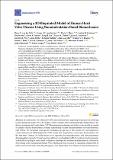Engineering a 3D-Bioprinted Model of Human Heart Valve Disease Using Nanoindentation-Based Biomechanics
Author(s)
van der Valk, Dewy C.; Blaser, Mark C.; Grolman, Joshua M.; Wu, Pin-Jou; Lee, Lang H.; Wen, Jennifer R.; Ha, Anna H.; Buffolo, Fabrizio; van Mil, Alain; Bouten, Carlijn V. C.; Body, Simon C.; Mooney, David J.; Sluijter, Joost P. G.; Aikawa, Masanori; Hjortnaes, Jesper; Aikawa, Elena; van der Valk, Dewy; van der Ven, Casper; Blaser, Mark; Grolman, Joshua; Fenton, Owen; Lee, Lang; Tibbitt, Mark; Andresen, Jason; Wen, Jennifer; Ha, Anna; Bouten, Carlijn; Body, Simon; Mooney, David; Sluijter, Joost; van der Ven, Casper F.t.; Tibbitt, Mark W; Langer, Robert S; Fenton, Owen Shea; ... Show more Show less
Downloadnanomaterials-08-00296.pdf (34.40Mb)
PUBLISHER_CC
Publisher with Creative Commons License
Creative Commons Attribution
Terms of use
Metadata
Show full item recordAbstract
In calcific aortic valve disease (CAVD), microcalcifications originating from nanoscale calcifying vesicles disrupt the aortic valve (AV) leaflets, which consist of three (biomechanically) distinct layers: the fibrosa, spongiosa, and ventricularis. CAVD has no pharmacotherapy and lacks in vitro models as a result of complex valvular biomechanical features surrounding resident mechanosensitive valvular interstitial cells (VICs). We measured layer-specific mechanical properties of the human AV and engineered a three-dimensional (3D)-bioprinted CAVD model that recapitulates leaflet layer biomechanics for the first time. Human AV leaflet layers were separated by microdissection, and nanoindentation determined layer-specific Young’s moduli. Methacrylated gelatin (GelMA)/methacrylated hyaluronic acid (HAMA) hydrogels were tuned to duplicate layer-specific mechanical characteristics, followed by 3D-printing with encapsulated human VICs. Hydrogels were exposed to osteogenic media (OM) to induce microcalcification, and VIC pathogenesis was assessed by near infrared or immunofluorescence microscopy. Median Young’s moduli of the AV layers were 37.1, 15.4, and 26.9 kPa (fibrosa/spongiosa/ventricularis, respectively). The fibrosa and spongiosa Young’s moduli matched the 3D 5% GelMa/1% HAMA UV-crosslinked hydrogels. OM stimulation of VIC-laden bioprinted hydrogels induced microcalcification without apoptosis. We report the first layer-specific measurements of human AV moduli and a novel 3D-bioprinted CAVD model that potentiates microcalcification by mimicking the native AV mechanical environment. This work sheds light on valvular mechanobiology and could facilitate high-throughput drug-screening in CAVD.
Date issued
2018-05Department
Massachusetts Institute of Technology. Department of Chemical Engineering; Koch Institute for Integrative Cancer Research at MITJournal
Nanomaterials
Publisher
MDPI AG
Citation
van der Valk, Dewy et al. "Engineering a 3D-Bioprinted Model of Human Heart Valve Disease Using Nanoindentation-Based Biomechanics." Nanomaterials 8, 5 (May 2018): 296 © 2018 The Authors
Version: Final published version
ISSN
2079-4991